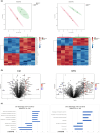Short-term starvation activates AMPK and restores mitochondrial inorganic polyphosphate, but fails to reverse associated neuronal senescence
- PMID: 39102875
- PMCID: PMC11561667
- DOI: 10.1111/acel.14289
Short-term starvation activates AMPK and restores mitochondrial inorganic polyphosphate, but fails to reverse associated neuronal senescence
Abstract
Neuronal senescence is a major risk factor for the development of many neurodegenerative disorders. The mechanisms that drive neurons to senescence remain largely elusive; however, dysregulated mitochondrial physiology seems to play a pivotal role in this process. Consequently, strategies aimed to preserve mitochondrial function may hold promise in mitigating neuronal senescence. For example, dietary restriction has shown to reduce senescence, via a mechanism that still remains far from being totally understood, but that could be at least partially mediated by mitochondria. Here, we address the role of mitochondrial inorganic polyphosphate (polyP) in the intersection between neuronal senescence and dietary restriction. PolyP is highly present in mammalian mitochondria; and its regulatory role in mammalian bioenergetics has already been described by us and others. Our data demonstrate that depletion of mitochondrial polyP exacerbates neuronal senescence, independently of whether dietary restriction is present. However, dietary restriction in polyP-depleted cells activates AMPK, and it restores some components of mitochondrial physiology, even if this is not sufficient to revert increased senescence. The effects of dietary restriction on polyP levels and AMPK activation are conserved in differentiated SH-SY5Y cells and brain tissue of male mice. Our results identify polyP as an important component in mitochondrial physiology at the intersection of dietary restriction and senescence, and they highlight the importance of the organelle in this intersection.
Keywords: dietary restriction; fasting; inorganic polyphosphate; metabolism; mitochondria; polyP; senescence.
© 2024 The Author(s). Aging Cell published by Anatomical Society and John Wiley & Sons Ltd.
Conflict of interest statement
The authors declare no conflict of interest.
Figures




References
-
- Abramov, A. Y. , Fraley, C. , Diao, C. T. , Winkfein, R. , Colicos, M. A. , Duchen, M. R. , French, R. J. , & Pavlov, E. (2007). Targeted polyphosphatase expression alters mitochondrial metabolism and inhibits calcium‐dependent cell death. Proceedings of the National Academy of Sciences of the United States of America, 104, 18091–18096. 10.1073/pnas.0708959104 - DOI - PMC - PubMed
-
- Angelova, P. R. , Agrawalla, B. K. , Elustondo, P. A. , Gordon, J. , Shiba, T. , Abramov, A. Y. , Chang, Y. T. , & Pavlov, E. V. (2014). In situ investigation of mammalian inorganic polyphosphate localization using novel selective fluorescent probes JC‐D7 and JC‐D8. ACS Chemical Biology, 9, 2101–2110. 10.1021/cb5000696 - DOI - PubMed
MeSH terms
Substances
Grants and funding
LinkOut - more resources
Full Text Sources

